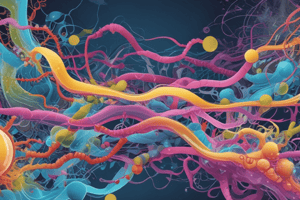Podcast
Questions and Answers
Protein digestion begins in the small intestine.
Protein digestion begins in the small intestine.
False (B)
The primary enzyme involved in proteolytic digestion is trypsin.
The primary enzyme involved in proteolytic digestion is trypsin.
False (B)
Trypsin cleaves peptide chains mainly at the amino side of the amino acids lysine or arginine.
Trypsin cleaves peptide chains mainly at the amino side of the amino acids lysine or arginine.
False (B)
Chymotrypsin preferentially catalyzes the hydrolysis of peptide bonds involving alanine and glycine.
Chymotrypsin preferentially catalyzes the hydrolysis of peptide bonds involving alanine and glycine.
Elastase breaks down proteins into free amino acids only.
Elastase breaks down proteins into free amino acids only.
Digested proteins are released into the lymphatic system.
Digested proteins are released into the lymphatic system.
The stomach's highly acidic environment is necessary for protein digestion.
The stomach's highly acidic environment is necessary for protein digestion.
Pepsin catalyzes the hydrolysis of peptide bonds at an optimal pH of 7.
Pepsin catalyzes the hydrolysis of peptide bonds at an optimal pH of 7.
Trypsin cleaves peptide chains mainly at the carboxyl side of the amino acids lysine or arginine.
Trypsin cleaves peptide chains mainly at the carboxyl side of the amino acids lysine or arginine.
Chymotrypsin prefers small hydrophobic residues.
Chymotrypsin prefers small hydrophobic residues.
Proteolytic enzymes break down proteins into free amino acids only.
Proteolytic enzymes break down proteins into free amino acids only.
Dipeptides and tripeptides are absorbed by the intestinal mucosa cells and released into the lymphatic system.
Dipeptides and tripeptides are absorbed by the intestinal mucosa cells and released into the lymphatic system.
Study Notes
Protein Digestion
- Protein digestion begins in the stomach, where the highly acidic environment denatures proteins, making them susceptible to proteolytic digestion.
- The primary enzyme involved in proteolytic digestion is pepsin, which catalyzes the nonspecific hydrolysis of peptide bonds at an optimal pH of 2.
Pancreatic Enzymes in Proteolytic Digestion
- In the small intestine, the pancreas secretes zymogens of trypsin, chymotrypsin, elastase, and other enzymes.
- Trypsin cleaves peptide chains mainly at the carboxyl side of lysine or arginine, except when either is followed by proline.
- Chymotrypsin prefers large hydrophobic residues and preferentially catalyzes the hydrolysis of peptide bonds involving tyrosine, phenylalanine, and tryptophan.
Absorption of Amino Acids and Peptides
- Proteolytic enzymes break down proteins into free amino acids, dipeptides, and tripeptides.
- These are absorbed by intestinal mucosa cells and subsequently released into the bloodstream, where they are absorbed by other tissues.
Protein Digestion
- Protein digestion begins in the stomach, where the highly acidic environment denatures proteins, making them susceptible to proteolytic digestion.
- The primary enzyme involved in proteolytic digestion is pepsin, which catalyzes the nonspecific hydrolysis of peptide bonds at an optimal pH of 2.
Pancreatic Enzymes in Proteolytic Digestion
- In the small intestine, the pancreas secretes zymogens of trypsin, chymotrypsin, elastase, and other enzymes.
- Trypsin cleaves peptide chains mainly at the carboxyl side of lysine or arginine, except when either is followed by proline.
- Chymotrypsin prefers large hydrophobic residues and preferentially catalyzes the hydrolysis of peptide bonds involving tyrosine, phenylalanine, and tryptophan.
Absorption of Amino Acids and Peptides
- Proteolytic enzymes break down proteins into free amino acids, dipeptides, and tripeptides.
- These are absorbed by intestinal mucosa cells and subsequently released into the bloodstream, where they are absorbed by other tissues.
Studying That Suits You
Use AI to generate personalized quizzes and flashcards to suit your learning preferences.


